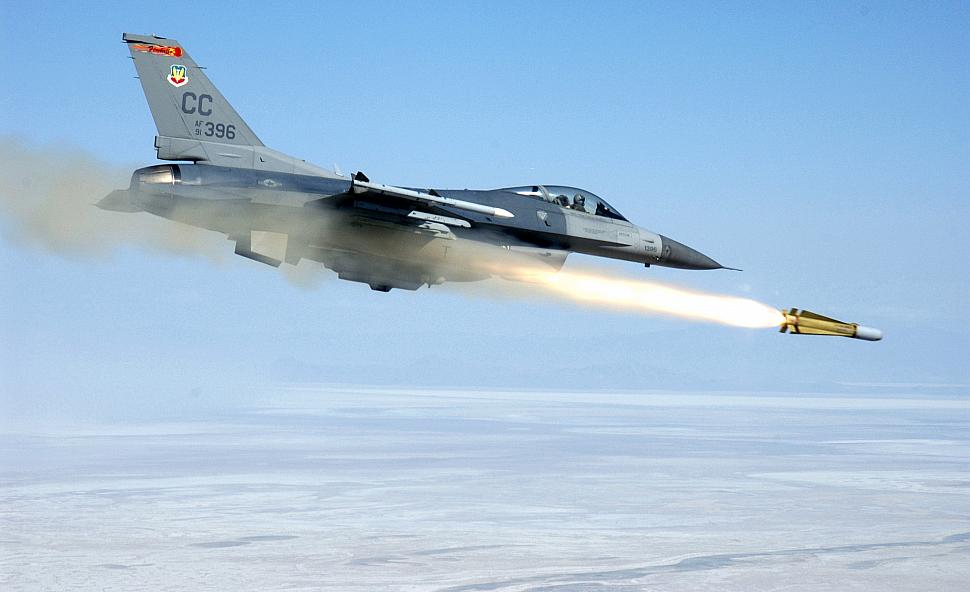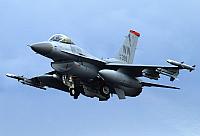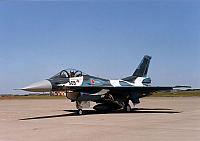Fighter Jet News
F-16 Fighting Falcon News
Japan deployment introduces Cannon AFB pilots to whole new kind of flying
February 27, 2005 (by
Jennifer H. Svan) -
With more than 300 days of sunshine a year in Clovis, N.M., some Cannon Air Force Base pilots deployed here at Misawa AB (Japan) for four months are experiencing a new phenomenon: Launching sorties in less-than-ideal weather - or not flying at all.

"We fly a lot more at Cannon," said Capt. SAM Stitt III, an F-16 pilot with 523rd Air Expeditionary Squadron. "We can see the ground at Cannon."
Nearly 40 fighter pilots are among the 250 or so Cannon airmen here for what Air Force officials have called a deployment to maintain a credible deterrent posture and presence in the region.
Misawa may have less sunshine than arid New Mexico, but remote northern Japan is presenting Cannon flying aces with some unique training opportunities.
Last week they participated in a joint training exercise with their Japan Air Self-Defense Force counterparts and the 13th Fighter Squadron at Misawa. Dubbed Seikan War, the exercise integrated F-16s with JASDF F-4s and F-2s. On Thursday afternoon, 28 U.S. and JASDF fighter pilots matched wits and weapons with 12 JASDF F-15 Eagles from the 2nd Air Wing at Chitose Air Base on Hokkaido.
In a fictitious battle waged over the Sea of Japan "the F-15s were defending their homeland against us," said Lt. Col. Ken Rizer, 523rd Expeditionary Squadron commander. "We were engaged in some sort of operation against them and needed to hit some targets up there." Acting as the enemy aircraft, the F-15s flew down from the north and "the fight was on," Rizer said.
The allied forces practiced both air-to-air and air-to-ground tactics, trying to shoot down enemy aircraft and bomb fake surface-to-air missile sites and other key land targets. No weapons were launched, officials said.
"It was an opportunity to integrate flying and work together," Rizer said.
All bombs hit their targets but both allied and enemy forces sustained losses, Rizer said.
Losses in training "translate into lessons learned, things we can do better," he said, adding: "Japanese F-15s are a tough adversary because they have fairly well-developed tactics. We've trained with them for a long time. They're pretty smart about our capabilities" and vice versa.
The exercise was the first time that many of the Cannon pilots had trained with JASDF.
"It was a coordinated effort to put bombs on target," Stitt said. "The more we train with these guys, the easier it will be real-world."
The language differences were a challenge, Stitt said, but as Rizer pointed out, "they speak better English than we do Japanese."

USAF F-16C block 50 #91396 assigned to the 522nd Fighter Squadron at Cannon Air Force Base, fires an AGM-65H Maverick air-to-ground missile at a target located over the Utah Test and Training Range. The mission was part of an air-to-ground weapons system evaluation program mission commonly referred to as Combat Hammer. The squadron is deployed to Hill AFB. [USAF photo by MSgt. Michael Ammons]
Nearly 40 fighter pilots are among the 250 or so Cannon airmen here for what Air Force officials have called a deployment to maintain a credible deterrent posture and presence in the region.
Misawa may have less sunshine than arid New Mexico, but remote northern Japan is presenting Cannon flying aces with some unique training opportunities.
Last week they participated in a joint training exercise with their Japan Air Self-Defense Force counterparts and the 13th Fighter Squadron at Misawa. Dubbed Seikan War, the exercise integrated F-16s with JASDF F-4s and F-2s. On Thursday afternoon, 28 U.S. and JASDF fighter pilots matched wits and weapons with 12 JASDF F-15 Eagles from the 2nd Air Wing at Chitose Air Base on Hokkaido.
In a fictitious battle waged over the Sea of Japan "the F-15s were defending their homeland against us," said Lt. Col. Ken Rizer, 523rd Expeditionary Squadron commander. "We were engaged in some sort of operation against them and needed to hit some targets up there." Acting as the enemy aircraft, the F-15s flew down from the north and "the fight was on," Rizer said.
The allied forces practiced both air-to-air and air-to-ground tactics, trying to shoot down enemy aircraft and bomb fake surface-to-air missile sites and other key land targets. No weapons were launched, officials said.
"It was an opportunity to integrate flying and work together," Rizer said.
All bombs hit their targets but both allied and enemy forces sustained losses, Rizer said.
Losses in training "translate into lessons learned, things we can do better," he said, adding: "Japanese F-15s are a tough adversary because they have fairly well-developed tactics. We've trained with them for a long time. They're pretty smart about our capabilities" and vice versa.
The exercise was the first time that many of the Cannon pilots had trained with JASDF.
"It was a coordinated effort to put bombs on target," Stitt said. "The more we train with these guys, the easier it will be real-world."
The language differences were a challenge, Stitt said, but as Rizer pointed out, "they speak better English than we do Japanese."
Published on February 27, 2005 in the Pacific edition of Stars and Stripes.
Used with permission from Stars and Stripes, a DoD publication.
© 2005 Stars and Stripes.
Additional images:
Related articles:
Tags
Tags


